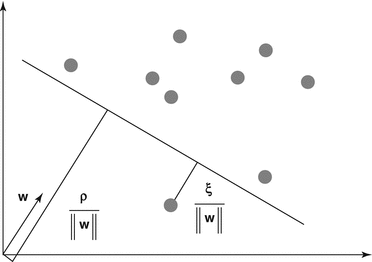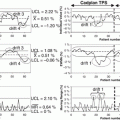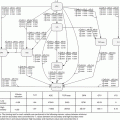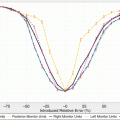(13.1)
subject to:

(13.2)

(13.3)

Fig. 13.1
One-class SVM. The problem of anomaly detection becomes separating data from the origin using a hyperplane (adapted with permission)
The training data could consist of examples of one class (safety class:  ), and the testing data could contain examples from safety and error classes. An
), and the testing data could contain examples from safety and error classes. An  would indicate an anomaly (error event).
would indicate an anomaly (error event).
 ), and the testing data could contain examples from safety and error classes. An
), and the testing data could contain examples from safety and error classes. An  would indicate an anomaly (error event).
would indicate an anomaly (error event).13.3 Application of Anomaly Detection to Radiotherapy QA
The application of machine learning to QA in radiotherapy involves multiple steps: data collection, extraction of relevant features for the safety endpoint of interest, grading of the safety endpoint, selection of appropriate learning algorithm, and defining the training/testing procedure. In Fig. 13.2, we show a corresponding flowchart for the example of the proposed error detection system using one-class SVM for QA of radiotherapy treatment planning. As shown, a one-class SVM anomaly detector is trained using extracted features from existing “safe” data. The extracted features could be treatment technique as well as cancer site dependent. Afterward, the trained anomaly detector is applied to new incoming treatment plans and a flag is turned on by the detector if an error is detected and the plan is sent back for review and this process is repeated till the plan is passed without any errors.


Fig. 13.2
Flowchart for radiotherapy error detection using one-class SVM anomaly detection
13.3.1 Dataset
To evaluate the proposed QA-SVM system for radiotherapy error detection, we considered a dataset of non-small cell lung cancer (NSCLC) patients who received stereotactic body radiation therapy (SBRT) as part of their treatment. The dataset consisted of 43 successfully treated SBRT patients who received 3 or 5 fractions with 6 or 18 MV beam energies on a linear accelerator (LINAC).
Stay updated, free articles. Join our Telegram channel

Full access? Get Clinical Tree





